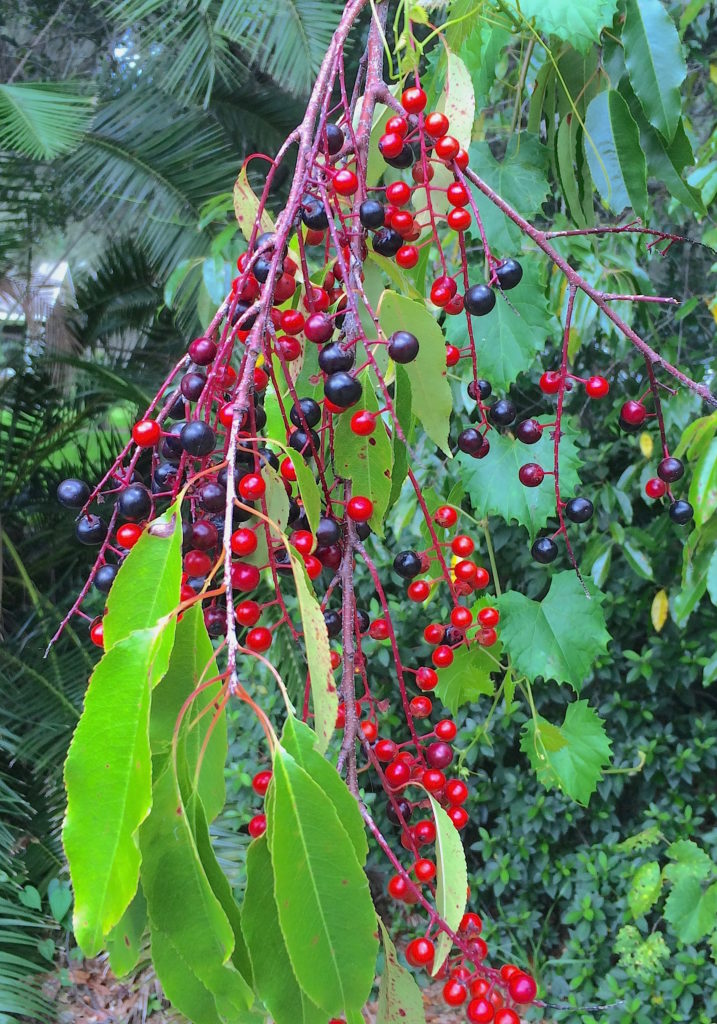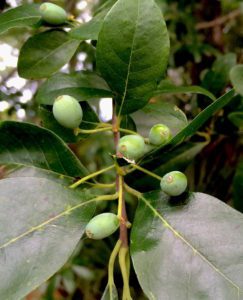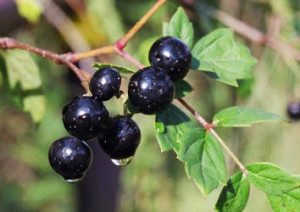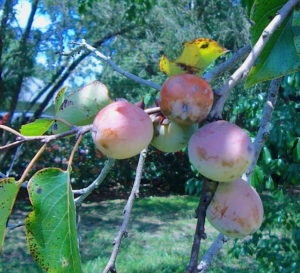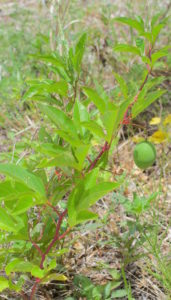This newsletter will have a “black” theme this week starting with Prunus serotina, or the Black Cherry.
It’s been mentioned a couple of times earlier this season and that’s the reason for it being mentioned now: The season. Its fruiting season seems to be longer this year. I saw trees picked free of fruit months ago but just this last week saw one heavy with fruit in Clermont (photo above.) A Black Cherry was also still fruiting in Jacksonville this past weekend during a foraging class. It is safe to say Black Cherries look better than they taste. There is an initial cherry sweetness but then a residual bitterness takes over. They are much better processed into wine and jelly (or medicine.) Do not eat the seeds. To read more about the Black Cherry go here.
Do you know why the Sweet Gum tree is called that? Because while it tastes mighty bad it is not as bad as the other “gum” trees, one of which is not season yet but is fruiting, the Black Gum.You have to like sour and bitter to like the Black Gum tree. If you don’t the fruit is offensive and elicits comments that cannot be printed in wholesome publications. This did not stop settlers from adding a lot of sugar to the fruit and making jelly out of it. The seed itself is easy to identify in that under the pulp there are vertical striations covering the seed. We saw a specimen this weekend in Jacksonville. The tree usually looks gangly and has branches that are often on a 90-degree angle to the trunk. To read more about the Black Gum and its nearly-offensive but edible relatives click here.
Putting on black fruit now is the controversial Pepper Vine, Ampelopsis arborea. It is closely related to the edible grape but also closely related to the toxic Virginia Creeper. It is one of those plants that some folks say is definitely toxic and others say definitely edible. My personal experience is that it is not edible, but I know some credible foragers who say they have eating the ripe berries for a long time with no issue. No doubt the problem has to do with annual calcium oxalate production. In small amounts it’s tolerable. In high concentrations it can cause skin problems or internally upset digestion. Pepper Vine (so-called because the fruit can give a pepper-like burn) apparently can make little to a lot of the chemical each year, varying greatly. Another possibility is method of preparation. It might be that when the berries are juiced and the juice is allowed to set in a cold environment that acid precipitates out leaving useable juice. That is not a fact, but rather speculation on my part. Lacking any definitive information it is a fruit best avoided unless you know for certain your fruit is edible. If you do experiment and survive, let me know.
Breaking with our theme — almost — we also saw a persimmon tree putting on fruit. They are green this time of year but the tree is the North American version of ebony. Persimmons are much maligned because they are astringent until extremely ripe. Or from the tree’s point of view it does not want the fruit carried away until the seeds are ready to grow. So the fruit says non-palatable to most creatures until the last moment. They seemingly turn sweet overnight. No frost is needed. The best persimmons are the ones you have to fight the ants for. They will be ripening around October, give or take a week or two. Remember, the place to look for persimmons are along edges…. edges of forests, edges of roads and rivers and paths. To read more about the persimmon go here.
Upcoming Foraging Classes:
Sunday, Aug 14th, Boulware Springs Park, 3420 SE 15th St., Gainesville, FL 32641. Meet at the picnic tables next to the pump house. We start at the park and on a small portion of the Gainesville-Hawthorne State Trail. 9 a.m.
For more information about the foraging classes go here.
All of Green Deane’s videos are available for free on You Tube. They do have ads on them so every time you watch a Green Deane video I get a quarter of one cent. Four views, one cent. Not exactly a large money-maker but it helps pays for the newsletter. If you want to see the videos without ads and some in lightly better quality you can order the DVD set. It is nine DVDs with 15 videos on each. Many people want their own copy of the videos or they have a slow service and its easier to order then to watch them on-line. They make a good gift for that forager you know. Individual videos can also be ordered. You can order them by clicking on the button on the top right of this page or you can go here.
Want to identify a plant? Perhaps you’re looking for a foraging reference? You might have a UFO, an Unidentified Flowering Object you want identified. On the Green Deane Forum we — including Green Deane and some 8,000 others from around the world — chat about foraging all year. And it’s not just about warm-weather plants or just North American flora. Many nations share common weeds so there’s a lot to talk about, such as the one to the left. There’s also more than weeds. The reference section has information for foraging around the world. There are also articles on food preservation, and forgotten skills from making bows to fermenting food. Recent topics include: Blolly or some kind of ficus? Pawpaw time in central Alabama. What is it? Edible Leguminous Tree. Subtropical Looks Like Winged Bean. Smilax? Roadside Plant. Weed In Garden. Those Special Places. Yellow Fruit Found Along River. Bee Humor. Pretty Purple Plant. Cultivated Apios Americana, Mushroom Identification Tips, Another Bolete: Edible? Wood Potato, Chocolate Mushie, Are All Crown Berries Edible? Keeping our cells young, and Apple-like fruit on a vine,. You can join the forum by clicking on the button on the upper right hand side of this page.
This is Newsletter 220.
If you would like to donate to Eat The Weeds please click here.

